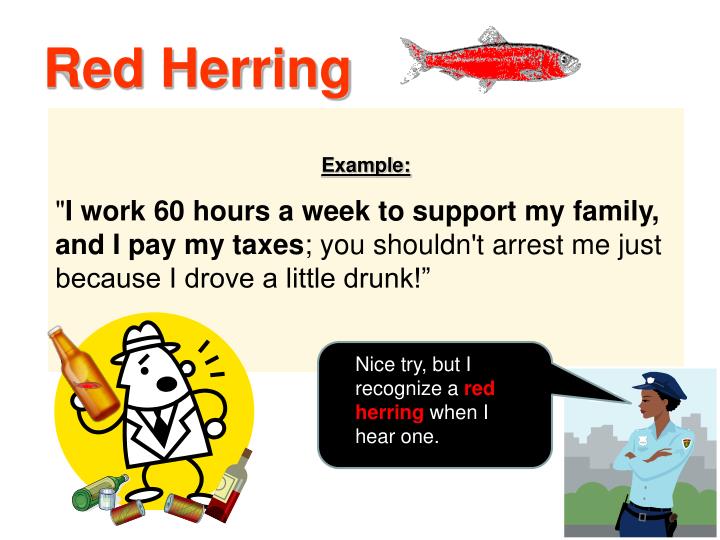

THE RED HERRING FALLACY SERIES
The last type of slippery slope fallacy, a conceptual slippery slope, argues that because it’s possible to get from one scenario to another through a series of steps, there is no fundamental difference between the two scenarios.
THE RED HERRING FALLACY FULL
If we allow this customer to give an IOU instead of paying their full bill, we’ll need to accept IOUs from anybody who can’t afford their entire bill.Here are a few examples of precedential slippery slope arguments: With a precedential slippery slope argument, the arguer claims that reacting to one issue in a specific way means they will have to react to other issues that may arise in the future in the same way, regardless of the issues’ similarity or lack thereof. More cars on the road will lead to more collisions, which will make our town a dangerous place to drive or walk. Widening the road will lead to more traffic in town.With less business, the stores will close, which will hurt our local economy. If students are required to wear uniforms to school, they’ll do less shopping at local clothing stores.Here are a few examples of the causal slippery slope fallacy: These are the three types of slippery slope fallacy: Causal slippery slope argumentsĪ causal slippery slope argument claims a minor inciting event will inevitably lead to a major outcome. Each revolves around the core of the slippery slope fallacy: the assumed relationship between two or more events or outcomes. There are a few different types of slippery slope arguments. What are the different types of slippery slope fallacies? Keep in mind that even if these outcomes turn out to be true, they are slippery slope arguments because of the assumed connection between the initial change and its result. Eliminating tolls will keep more money in tourists’ pockets, which they’ll spend on local attractions while they’re here.By spending more time with their families, they’ll be happier and more productive at work. By switching to a four-day workweek, employees will have more time to spend with their families.It’s possible to make a slippery slope argument in favor of something, like in these examples: Although it’s usually used to argue against taking a specific action, a slippery slope argument isn’t, by definition, an argument against something.

This extends to legislation-the slippery slope fallacy comes up a lot in discussions about policy changes. īut let’s get back to the slippery slope fallacy, which is often used to argue against making a specific decision. With the appeal to probability, the arguer assumes that because something is possible, it’s guaranteed. If we cancel our trip, the weather will be beautiful.The appeal to probability fallacy is a formal fallacy. In contrast, a formal fallacy is an argument where the conclusion does not logically follow the premise. Other informal fallacies include the red herring fallacy and the ad hominem fallacy. If you leave your car unlocked overnight, you face a higher risk of someone breaking into it.In other words, it’s possible to make a logical argument in the same format as a slippery slope claim, like in this example: That means that the logical disconnect is within the argument’s content, rather than its structure. The slippery slope fallacy is an informal fallacy. First, let’s learn exactly what the slippery slope fallacy is, what it covers, and how it’s used. We’ll cover non-fallacious uses of the slippery slope later in this post. If you don’t take honors courses, your application may be less attractive to a good college.That’s what separates the slippery slope fallacy from logically extrapolating how a scenario will likely turn out: But to claim that you can’t get accepted to a highly ranked college without taking honors courses is inaccurate-and fallacious. Obviously, taking a rigorous course load as a high schooler generally makes you a more attractive applicant to colleges. If you don’t take honors courses, you won’t get into a good college.Here is a quick example of the slippery slope fallacy: Other names for the slippery slope fallacy include the dam burst fallacy, domino fallacy, and thin end of a wedge. This could be by directly causing that follow-up event, setting a precedent for it, or simply creating an environment where that follow-up event can occur. The slippery slope fallacy is a logical fallacy that claims one event or action will lead to another, more extreme event or action. Grammarly helps you communicate confidently Write with Grammarly What is the slippery slope fallacy?


 0 kommentar(er)
0 kommentar(er)
